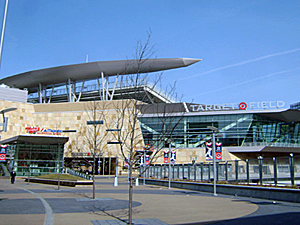The Twins' Target Field Scores as a Green Building All-Star

Target Field, theMinnesota Twins' new $545 million ballpark, has earned LEED-Silver certification, becoming the second Major League Baseball stadium to pass muster under the standards set by the U.S. Green Building Council.
The council, through its Green Building Certification Institute, conferred the rating on Target Field on Thursday, just in time for the ball club's first home opener at the new stadium on Monday.
The Washington Nationals' ballpark, so far the only other MLB stadium to achieve green building certification, also has LEED-Silver certification, which was awarded in 2008. However, Twins' management emphasizes the teams are not tied: Target Field scored 36 LEED points in acquiring its rating; National Park had 34. Building the open-air ballpark in Minnesota's historic Warehouse District posed a number of challenges, including its location -- the site sits on a former brownfield -- and securing funding to support the green design and pursuit of LEED certification.
Building the open-air ballpark in Minnesota's historic Warehouse District posed a number of challenges, including its location -- the site sits on a former brownfield -- and securing funding to support the green design and pursuit of LEED certification.
In order to build the park, contaminated soil was treated and replaced. Groundwork included the installation of a giant cistern, which is buried beneath the warning track. Water collected in the cistern will be filtered and used for irrigation and hosing down the seating bowl. The site was a made a hub for public transportation by buses, commuter trains and light rail service. "Target Field is baseball's most urban ballpark, and the site constraints we faced were actually paramount to achieving LEED certification," said Earl Santee, senior principal atPopulous, the design firm that managed the certification process for the ballpark.
"Target Field is baseball's most urban ballpark, and the site constraints we faced were actually paramount to achieving LEED certification," said Earl Santee, senior principal atPopulous, the design firm that managed the certification process for the ballpark.
"With the addition of new, immediate access to public transportation at the ballpark, we've helped to bridge the site to its urban surroundings as a model for positive growth," Santee said in the team's announcement of its certification.
Local legislation related to the ballpark passed in 2006 set LEED certification as a goal of the project, if grant funds were available to support the strategy. But the construction timetable for the complex project couldn't accommodate waiting for the outcome of outside grant requests. So the Twins provided $1.5 million and theMinnesota Ballpark Authoritycontributed $1 million in additional resources in December 2007.
最后,获得LEED认证的成本不到整个项目的0.5% - 投资球场领导者预计,通过节省的能源和其他运营成本,投资棒球选项将偿还的费用将超出。
"The (ballpark) authority is pleased that our investment will pay dividends for years to come as fans learn more about the importance of sustainable design when they visit Target Field," Minnesota Ballpark Authority Chair Steve Cramer said in a prepared statement. 目标字段的其他绿色设计元素包括:
目标字段的其他绿色设计元素包括:
- High efficiency field lighting, interior lighting and heating/cooling and ventilation equipment.
- Low-flow urinals and dual-flush toilets.
- Recycling collection points throughout the stadium.
- 球场经理估计,在三场比赛中,估计有400立方码的材料将被回收,而不是去垃圾填埋场。
- The recycling of more than 70 percent of the construction waste generated in building the ballpark.
- Locally sourced building materials and use of building materials made from recycled content. More than 30 of the materials installed at the park contain recycled content -- the canopy structure, masonry blocks, carpet and the foul poles.
Populous, established in 1983, has made its name in designing major sports venues, convention centers and civic areas around the world. Target Field is the fourth sports project in the company's portfolio to earn LEED certification. The firm has worked with 24 MLB franchises, 30 NFL franchises, 80 professional and civic arenas, 40 major soccer and rugby teams, 120 universities, 40 convention centers and 29 equestrian clients.
Mortenson Construction是目标现场项目的建造者。该公司总部位于明尼阿波利斯,在美国六个城市,加拿大和中国设有办事处。该公司在双城地区建造了几个地标,包括MacPhail音乐中心,富国银行塔,明尼阿波利斯中央图书馆和明尼阿波利斯会议中心和扩张。
Images courtesy of Populous and the Minnesota Twins.
{related_content}




